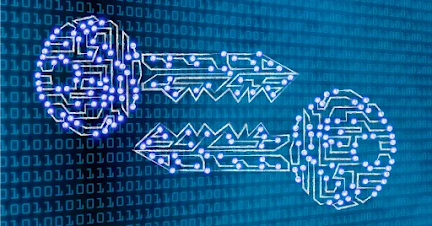Unlocking Secrets: The Intriguing World of Cryptography and How It Secures Your Digital Life
In Cryptography and Encryption the vast landscape of the digital age, where information flows freely and data breaches have become all too common, the concept of cryptography emerges as the unsung hero. Cryptography, the art of secure communication through the use of codes and ciphers, plays a pivotal role in safeguarding our digital lives. In this article, we will delve into the captivating realm of cryptography, exploring its significance, the science behind it, and how it ensures the privacy and security of our online interactions.
Table of Contents
1. Introduction
2. Understanding Cryptography
- The Historical Footsteps
- The Science of Encryption
3. Encryption Tools and Techniques
- Symmetric Encryption
- Asymmetric Encryption
- Quantum Cryptography
4. Cryptography in Everyday Life
- Securing Financial Transactions
- Privacy in Communication
5. The Role of Cryptography in Cybersecurity
- Preventing Data Breaches
- Safeguarding Sensitive Information
6. Cryptography's Cat and Mouse Game
- The Constant Evolution of Threats
- The Innovation in Encryption
7. The Future of Cryptography
- Post-Quantum Cryptography
- The Ethical Debate
8. Conclusion
9. FAQ
Understanding Cryptography
The Historical Footsteps
Cryptography's roots trace back to ancient civilizations, where messages were concealed through rudimentary cipher techniques. From the Caesar cipher to the Enigma machine of World War II, the history of cryptography is brimming with stories of secrecy and code-breaking.
The Science of Encryption
Encryption, the cornerstone of cryptography, involves converting plain text into an unintelligible format, decipherable only with the appropriate key. This process ensures that even if intercepted, the message remains indecipherable gibberish to anyone without the decryption key.Encryption Tools and Techniques
Symmetric Encryption
Symmetric encryption, also known as secret-key encryption, employs a single key for both encryption and decryption. While efficient, it faces challenges in securely distributing the key to the intended recipient.Asymmetric Encryption
Asymmetric encryption uses a pair of keys: a public key for encryption and a private key for decryption. This technology revolutionized secure communication by resolving the key distribution issue.Quantum Cryptography
The emerging field of quantum cryptography leverages the principles of quantum mechanics to create unbreakable encryption. It relies on the behavior of quantum particles to establish secure communication channels.
Cryptography in Everyday Life
Securing Financial Transactions
Online banking and e-commerce rely on cryptography to ensure the confidentiality and integrity of financial transactions. Secure Sockets Layer (SSL) certificates encrypt data during online purchases, thwarting potential cyber threats.Privacy in Communication
End-to-end encryption tools like Signal and WhatsApp employ cryptography to protect the privacy of conversations. This ensures that only the intended recipients can access the messages, shielding them from prying eyes.The Role of Cryptography in Cybersecurity
Preventing Data Breaches
Cryptography forms the backbone of cybersecurity measures by encrypting sensitive data stored on servers. Even if hackers manage to infiltrate systems, the encrypted data remains unreadable without the decryption key.Safeguarding Sensitive Information
Government agencies and corporations use encryption to safeguard confidential information. Technologies like Full Disk Encryption (FDE) ensure that data remains encrypted even if physical devices are stolen.
Cryptography's Cat and Mouse Game
The Constant Evolution of Threats
As technology advances, so do hacking techniques. Cryptography faces a perpetual challenge of staying ahead of cybercriminals who continuously innovate to crack codes and compromise security.The Innovation in Encryption
To counter evolving threats, encryption methodologies are constantly refined. The advent of post-quantum cryptography aims to develop algorithms that can withstand attacks from quantum computers.The Future of Cryptography
Post-Quantum Cryptography
As quantum computers inch closer to reality, the vulnerability of traditional encryption becomes apparent. Post-quantum cryptography seeks to create algorithms that can resist attacks from these powerful machines.
The Ethical Debate
While cryptography offers immense benefits, it also raises ethical concerns. The tension between privacy and security versus lawful access to information sparks debates about backdoors in encryption systems.Conclusion
In a world where digital interactions dominate, the role of cryptography cannot be overstated. From safeguarding financial transactions to preserving the privacy of our conversations, cryptography acts as a formidable shield against cyber threats. As technology advances and new challenges arise, the evolution of encryption techniques ensures that our digital lives remain secure.FAQs
1. What is cryptography's primary function?
- Cryptography's main purpose is to secure communication by converting information into an unreadable format that can only be deciphered by authorized parties.
2. How does quantum cryptography work?
- Quantum cryptography utilizes the principles of quantum mechanics to establish secure communication channels. It relies on the behavior of quantum particles to detect eavesdropping attempts.
3. Is cryptography foolproof?
- While cryptography provides strong security, no system is entirely foolproof. The strength of encryption depends on the algorithm used and the complexity of the key.
4. What is the significance of asymmetric encryption?
- Asymmetric encryption addresses the key distribution challenge by using a pair of keys. The public key encrypts messages, while the private key decrypts them.
5. How does post-quantum cryptography prepare us for the future?
- Post-quantum cryptography aims to develop encryption methods that can withstand attacks from quantum computers, ensuring long-term security in the face of advancing technology.










0 Comments